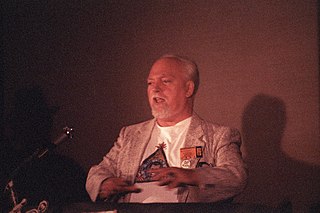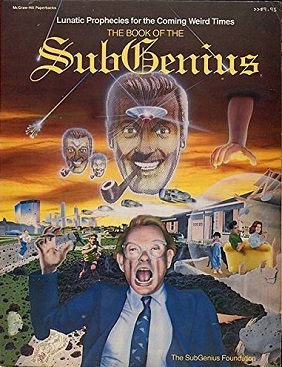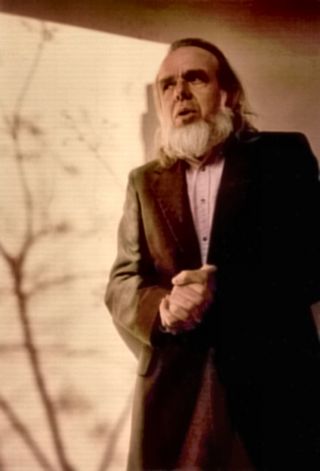Beliefs
Deities
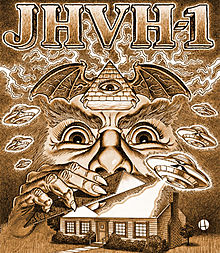
The Church of the SubGenius's ostensible beliefs defy categorization or a simple narrative, often striking non-believers[ weasel words ] as bizarre and convoluted. [10] The group has an intricate mythology involving gods, aliens, and mutants, which observers usually consider[ weasel words ] satire of other religions. [5] Its primary deity, generally known as Jehovah 1, [2] is an extraterrestrial who contacted Dobbs in the 1950s. Various accounts state that the encounter occurred while Dobbs was building a television or watching late-night television. [14] [15] Jehovah 1 gave him supernatural knowledge of the past and future, in addition to incredible power. [14] Dobbs then posed deep questions to the alien, receiving mysterious answers. [16] Some of their discussion centered on a powerful conspiracy, to which the Church attributes command of the world. [2]
Jehovah 1 and his spouse Eris, regarded by the Church as "relatively evil", are classified as "rebel gods". [17] SubGenius leaders note that Jehovah 1 is wrathful, a quality expressed by his "stark fist of removal". [9] The Church teaches that they are part of the Elder Gods, who are committed to human pain, but that Jehovah 1 is "relatively good" in comparison. Yog-Sothoth, a character from H. P. Lovecraft's Cthulhu Mythos, is the Elder Gods' leader. In her 2010 study of the Church of the SubGenius, religious scholar Carole Cusack of the University of Sydney states that Lovecraft's work is a "model for the Church of the SubGenius's approach to scripture", in that aspects of his fiction were treated as real by some within paganism, just as the Church appropriates aspects of popular culture in its spirituality. [18]
J. R. "Bob" Dobbs
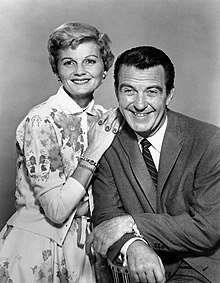
SubGenius leaders teach that J.R. "Bob" Dobbs's nature is ineffable and consequently stylize his nickname "Bob" with quotation marks even when used alone. [19] [20] They call him a "World Avatar" [9] and hold that he has died and been reborn many times. [10] The Church's primary symbol is an icon of his face in which he smokes a pipe. [2] Stang has said the image was taken from Yellow Pages clip art, [19] and it has been likened to Ward Cleaver, [10] Mark Trail, [15] or a 1950s-era salesman. [2] The Church's canon contains references to aspects of United States culture in that decade; [21] religious scholar Danielle Kirby of RMIT University argues that this type of reference "simultaneously critiques and subverts" the American dream. [22]
In one version of the Church's mythology, Jehovah 1 intended Dobbs to lead a powerful conspiracy and brainwash individuals to make them work for a living. Dobbs refused; instead, he infiltrated the group[ clarification needed ] and organized a counter-movement. Church leaders have taught that he was a very intelligent child and, as he grew older, studied several religious traditions, including Sufism, Rosicrucianism, and the Fourth Way. [23] Another key event in his life occurred when he traveled to Tibet, where he learned vital truths about topics including Yetis; the Church teaches that SubGenius members are descended from them. Originally, the only relative of Dobbs the Church identified was his mother, Jane McBride Dobbs –Church leaders cite his lack of resemblance to his mother's husband as the reason for not revealing his father. [23]
In another version, as a child "Bob," then known as Bobby, was not highly intelligent, but incredibly lucky. He copied the homework of Constance "Connie" Marsh, who later became a model, actress, and finally his wife as Constance "Connie" Marsh Dobbs [24] [25] [26] SubGenius leaders identify the couple as archetypes of the genders in a belief that resembles Hindu doctrines about Shiva and Parvati. [14] Church literature has variously described Dobbs's occupation as "drilling equipment" or fluoride sales, [9] [15] and accounts of his life generally emphasize his good fortune rather than intelligence. [25] [21] SubGenius leaders believe he is capable of time travel, and that this results in occasional changes to doctrine (the "Sacred Doctrine of Erasability"). Consequently, members attempt to follow Dobbs by eschewing unchangeable plans. [21]
Conspiracy and "Slack"
The Church of the SubGenius's literature incorporates many aspects of conspiracy theories, [27] teaching that there is a grand conspiracy at the root of all lesser ones. [19] It says that there are many UFOs, most of which are used by the conspiracy leaders to monitor humans, though a few contain extraterrestrials. In the Church's view, this conspiracy uses a façade of empowering messages but manipulates people so that they become indoctrinated into its service. [9] The Church calls these individuals "pinks" and states that they are blissfully unaware of the organization's power and control. [28] SubGenius leaders teach that most cultural and religious mores are the conspiracy's propaganda. [21] They maintain that their followers, but not the pinks, are capable of developing an imagination; the Church teaches that Dobbs has empowered its members to see through these illusions. Owing to their descent from Yetis, the Church's followers have a capacity for deep understanding that the pinks lack. [9] Cultural studies scholar Solomon Davidoff states that the Church develops a "satiric commentary" on religion, morality, and conspiracies. [27]
SubGenius members believe that those in the service of the conspiracy seek to bar them from "Slack", [27] a quality promoted by the Church. Its teachings center on "Slack" [5] (always capitalized), [20] which is never concisely defined, though Dobbs is said to embody it. [2] [29] Church members seek to acquire Slack and believe it will allow them the free, comfortable life (without hard work or responsibility) they claim as an entitlement. [14] [30] Sex and the avoidance of work are taught as two key ways to gain Slack. [20] Davidoff believes that Slack is "the ability to effortlessly achieve your goals". [27] Cusack states that the Church's description of Slack as ineffable recalls the way that Tao is described, [9] and Kirby calls Slack a "unique magical system". [31]




